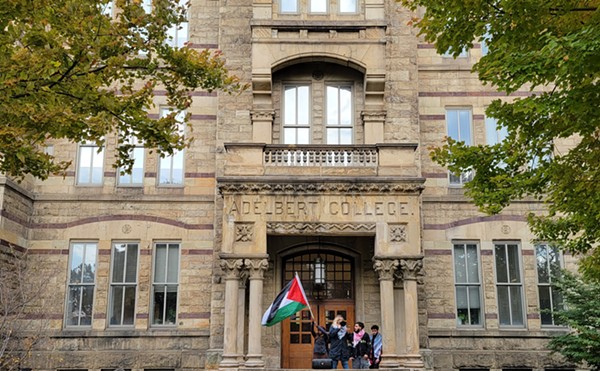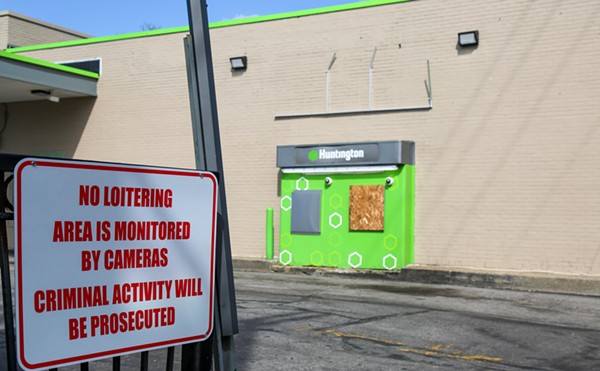Thus begins another long, lazy afternoon of drinking at this bedrock of West Park commerce. With its gleaming bar and orange, white, and green flags hanging from the ceiling, it's a gussied-up version of a traditional Irish pub, where the menu includes the requisite fish fries and corned-beef specials.
Retired cop Ed Kelly, a wisecracking woman named Joyce, and two firemen have begun nursing beers and providing the afternoon's entertainment. Today's topic is a sore one: Cleveland's rule forcing its workers to live within city limits.
Last year, the police and fire unions finally succeeded in getting a state law to overturn it. But thanks to the inevitable appeals, they've been holding their breath ever since.
"Do you think it's ever gonna pass?" Joyce asks Kelly, the wizened Yoda of the group.
"It should," he offers in a low, gravelly voice. "The city has no right to tell me where to live."
Back in his day, it wasn't an issue. Cops didn't have to live in the city, but men like Kelly flooded to this neighborhood anyway. He bought a $17,000 house in 1962 and worked two jobs to send his kids to Catholic school. Life was good in this part of Cleveland, even when the Hough riots turned distant neighborhoods into war zones.
Forty-five years later, not much has changed for city workers here. Those in uniform catch a few hours of sleep before heading off to second jobs working security at Indians games, grocery stores, bars, or anywhere else that's hiring. Over at the firehouse, their colleagues spend 24-hour shifts cleaning up fires and mangled pieces of flesh on I-90, then devote their days off to carpentry, electrical work, or side businesses.
If the American work ethic is dead, you won't find the evidence here.
While the rest of Cleveland was hammered by layoffs, crime, and an epidemic of men abandoning their families, West Park not only survived; it thrived. American flags fly over carefully trimmed rose bushes. Rows of solid brick homes sell for prices on par with Lakewood -- with comparable safety. The concentration of blue uniforms has a way of discouraging bad guys from robbing the grandma next door or hawking their wares on street corners.
But there was one thing the resilience of West Park could never cure: the public schools. It wasn't just the miserable graduation rates or the decades of corrupt management that have made them among the country's worst. Once you've broken up gang wars or witnessed security guards hitting on sophomores in the hallway, sending your kids to Cleveland's schools seems tantamount to child abuse.
One refuge, of course, has always been the Catholic schools. But they too have now failed West Park's residents -- at least economically speaking. These days, the annual tab for three kids in high school can reach $30,000 -- a price not even two jobs and an Old Testament frugality can overcome.
So cops and firemen are left with a torturous dilemma. They were never the kind to hold off until age 35 and professional security before having kids. They tend toward old-school Irish Catholic values, which dictate breeding early and often. And more so than most, they're intimately familiar with the ineptitude of their employer. Few have faith the schools will ever improve. Their only choice is to flee.
"It comes down to public schools," says one fireman who refuses to provide his name.
So if the state succeeds in abolishing the residency law, many will take flight to Fairview, North Olmsted, and Parma, leaving whoever's left to write West Park's obituary.
It's easy to see why city leaders battle so hard to keep them. In 1982, when the residency rule was approved by voters, City Hall had recently gone into default under the disastrous reign of Mayor Dennis Kucinich, and school busing was pushing families out in droves. If they were footing the bill for city paychecks, voters reasoned, the least city workers could do was to stay and help staunch the bleeding.
A quarter-century later, Kucinich is distracted by presidential glory, and busing is a historical footnote, but the hemorrhaging has only intensified. According to the latest Census count, only New Orleans and Detroit are suffering greater evacuation. Allowing a mass exodus of cops and firemen from Old Brooklyn, Collinwood, and West Park would be akin to turning out the lights. After Detroit lifted its residency requirement in 2000, more than 20 percent of the police force fled in the first year, according to the Detroit Free Press.
Such rules have a common thread nationwide: Living in the city gives workers greater incentive to keep the roads plowed, parks clean, and the crack dealers off the corner. Besides, if you knew the deal when you took the job, no one wants to hear complaints on the back end. You want the pension and the paycheck? Live here. Want to send your kids to Parma schools? Get a job on Parma's police force.
"There's nothing wrong with living where you work," says West Park resident Terry Stiles.
But it's one thing to dictate living arrangements in livable cities like Columbus, Denver, or even Pittsburgh. It's an entirely different sacrifice when you're forced to reside in America's poorest city, where a barely functioning government does its best to dispel hope.
A few blocks from the Public House, at Fire Station 39, the men are intimately familiar with this sacrifice. In the warm, quiet expanse of daylight between lunch and dinner, when alarms seldom ring and the coffee has grown stale, the tales flow easily.
A white-haired veteran named Mike has lived in the neighborhood for 18 years. He worked three jobs to put two kids through Catholic school. He got lucky when his son was accepted into St. Ignatius. The school gave him a break on tuition, charging just $11,000 -- instead of the current bill of $40,000 -- for all four years. At the time, there was an unwritten rule: As long as the children of cops and firemen got good grades, "they take care of 'em," he says.
But the Cleveland Diocese is now under the same fiscal pressure as its West Park parishioners. With its 800,000-member flock departing to distant suburbs, city Catholic schools must raise from tuition what's been lost from Mass collection plates. And a fireman's meager raises are no match for ascending school bills.
Maybe that's why Rick, a blue-eyed, round-bellied lieutenant now settled in a recliner, sends his three kids to West Park Community, the charter school down the road. When his son went to Clara Westropp for kindergarten, administrators held a meeting to start a PTA. Rick was one of only four parents who showed up. "That tells us a lot," he says. Namely, there was no way his kids would remain in public schools.
If he could move to Fairview or Lakewood today, he would. In fact, the city has already lost plenty of young firemen that way. Either their wives give them ultimatums, or the sacrifice proves too much.
Take fireman Sam DeVito. In the mid-'90s, his teenaged son was diagnosed with a brain tumor. DeVito and his ex-wife decided it was best for him to stay at his mom's house in Mentor while he received chemotherapy. But thanks to the city's rules, DeVito couldn't move to be near him. To keep his job, he had to commute between Mentor and his home in Collinwood.
The man trained to rescue strangers watched helplessly as his son went blind. The boy battled on, even graduating from high school. But cancer eventually won. DeVito was left to remember every hour he spent on the freeway instead of with his son.
He doesn't like to talk about the past these days, but he makes his feelings clear: "Your wife and child have rights too. It's a family decision, and I lived it."
Given such hardships, it's easy to imagine that cops and firemen would jump at the chance to flee, leaving neighborhoods like West Park ghost towns.
But fueling such fears won't help their cause. So after years of fighting for the opportunity, many argue the inevitable won't occur. They point out that the roughly 8,300 people who work for the city are only a tiny percentage of the population. Plus, they can't all leave at once. A badly slumping real-estate market, coupled with a flood of homes for sale, does not a seller's market make.
"It's not gonna be the gloom and doom that they like to project," says Steve Loomis, president of the police union.
Besides, it's not their responsibility to protect the city by day and uphold a sinking ship after clocking out. "Something's wrong if 9,000 [city workers] are holding up the whole damn city," Rick says.
They're quick to point to colleagues who've decided to stay in Cleveland -- at least for a while. Take firefighter Derek Jarvis. He recently moved his son out of parochial school into Riverside Elementary. He's planning to stay at least until his son finishes eighth grade. "If there's a reason to stay, people will stay," he says. "Let's make reasons to stay."
Then there's Tom Ross, the recording secretary for the police union. A jovial guy whose broad shoulders and thick neck give away his profession even without the uniform, he bought his house in 2003, just before the layoffs, when he went without work for six months. He's recently married and plans to stay for seven or eight years -- until he and his wife have kids and can move to the suburbs.
"We're making a commitment here," he explains from a living room filled with wedding gifts.
The priest who married Ross is here. And just a few blocks away, he can visit the glistening slabs of granite and somber row of flags that compose the police and firefighter memorial. Overlooking the edge of Rocky River Reservation, it's a landmark you can't miss when driving into West Park from I-90. And it speaks volumes about the neighborhood's priorities. After Detective A. J. Schroeder was killed while trying to arrest a rape suspect, every street was illuminated by candlelight.
"People aren't gonna abandon this neighborhood," he says. "We have an investment here, and we love it here."
He may be right -- at least for the time being. The proud rows of fairy-tale cottages near Rocky River Drive, with their prim lawns and trees dressed with blue ribbons for fallen officers, won't disappear overnight.
But if West Park survives, it will do so only by defying the laws of Rust Belt migration. From Millionaires' Row to Rockefeller's old stomping grounds, from Slavic Village to Cudell, the recipe for a ghetto continues to renew itself with lockstep familiarity. As the for-sale signs sprout, the whites move out and the middle-class blacks arrive. They, in turn, take flight when poorer blacks move in.
Here in West Park, neighbors can already see it coming.
Gary Swilik has lived in a ranch home on the eastern end for eight years. He grew up in the neighborhood, and remembers buying comic books and eating at the lunch counter at 137th and Lorain. Now the area plays host to run-down strip malls, check-cashing stores, and a tavern with bars on the door. Recently, he was shocked to spot a hooker parading in broad daylight.
"That's something I never thought I'd see," he says.
Mike, a fireman from Station 39, has noticed the changes too: "You're starting to get the punks walking up and down the street with their butts hanging out."
Around Puritas, the scenery is beginning to mirror the hollowed-out desperation of south Collinwood and Slavic Village. Payday lenders have descended, as have the trash and weeds that litter yards. Once a prosperous thoroughfare, it's now a continuum of cracked asphalt and neglected buildings, where the most inviting storefronts are the occasional Burger King or liquor store.
At Rubin's Restaurant & Deli on Lorain near 147th, the soothingly kitschy decor and early-bird-special atmosphere has been invaded by a new reality. The manager was recently forced to close shop on weeknights, because the drug dealers and "bad girls" hawking their wares intimidated customers and became too much to handle.
Such problems have yet to migrate further west. Near Riverside Elementary, Terry Stiles stands in his front yard, watering plants in a tank top that reveals an impressive collection of tattoos. He describes a comfortable closeness unheard-of in most of the city. "We all say hi; everybody waves. It's real old-school. This is the little Cleveland," he says.
But if the city workers go, much of that could be lost. "I just don't think it would get any better," Stiles says.
Some residents have already reached their tipping point. Mike estimates there are probably 10 houses for sale on his street. "They're thinking: Get out before it gets bad."
One single woman, who lives near Warren Village but won't provide her name for fear of retaliation from neighbors, is disgusted by the city's indifference to the deterioration around her. "I'm just totally disillusioned and wish I could move," she says.
Last October, her neighbor's kid burned down his house and damaged hers. Eight months later, a hole remains -- decorated with debris and weeds -- where the house once stood. It took four calls to Councilman Martin Keane to get a response to complaints. When someone from the city finally called, the response was typical of Cleveland government: "Wait a minute, young lady. That's not my department."
When she moved in 14 years ago, she wanted to be part of Cleveland's comeback. There were three bids on her house in one day. But now, she's not even sure it's worth the investment to fix. The houses around her are losing value, and a fireman who lived a couple doors down took a year to sell his home.
Sharon DeCarlo is asking the same questions. She and her husband would seem ideal homeowners. She works for a law firm; he renovates houses. They've lived for nearly 21 years at the southeastern end of West Park and send their kids to John Marshall High. But they haven't been rewarded for their loyalty.
For years they've been waiting for the promised renovation of John Marshall. DeCarlo joined a community team that complained about mold and took pictures of the broken windows in the crumbling albatross on West 140th Street. School officials kept telling her the project was on hold until a new West Side high school was built. But they've now decided against building it -- and still can't say when John Marshall will be fixed.
"I'm dying to know what their plan is," she says drily. "I'm sure it's just wonderful."
While she waits, she gets a ringside view of the future crumbling around her. In the last four years, more single-parent families have moved onto her street, bringing young kids who are allowed to run wild. Homeowners are being replaced by renters, and the house across the street was sold to an investor -- the telltale staple of economic ruin, the absentee landlord.
"It's unbelievable how they don't work to attract and retain viable residents," she says of the city.
That's why, when the kids graduate, she wants to move. Like many of her neighbors, she stuck it out longer than most, pledging allegiance to a city that's given her little more than parking tickets in return. But now she too can see the writing on the wall.
"I'm sick of this life."













